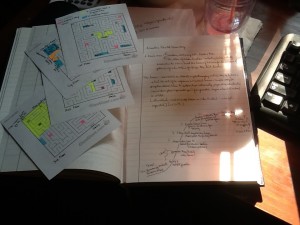Who out there already knows I’m something of a luddite? Yeah, yeah, put your hands down. It’s no big secret. I come from a time when most of us still wrote term papers on typewriters and only engineers learned about computers because they needed to talk to them in complex languages.
I learned the basics (though not Basic) and enjoyed interacting with the new electronic friends to some extent, but I still wrote stories out longhand. Fast forward several years *cough cough decades cough* and I manage, but I’ll never be one of those people who always needs the newest, fastest, smartest thing out there. Scott’s seen my phone. He’ll tell you.
I still keep story notes in notebooks. Not the stories – but the notes. Plot arcs, character notes, maps, and so on. My current one is a lovely bound blank book with little page flags, and though my story notes have become more and more compact over the years as I’ve worked out what I need, they can still be a bit messy.
Most of my author friends use some sort of program to keep track of story detritus, flotsam and jetsam and important crap. And while I will probably never own one of these programs, some of them are vociferously dedicated to their chosen app, so I thought I’d share some of their thoughts on story organization software:
Scrivener – this one’s a deep dive organizational tool that can help you with every aspect of your story. Those who do better with organized work spaces and who like detailed and robust abilities in a story partner seem to gravitate toward this one. It’s an all in one, also usable as a word processor. Some things Scrivener proponents had to say (names are omitted, cause I didn’t get to ask everyone if they wanted to be cited.) –
“I can group the information how I want it. It’s organized.”
“I like that each scene can be a separate file but I see them all at once. I also like that I have a research sections for files – text and images.”



